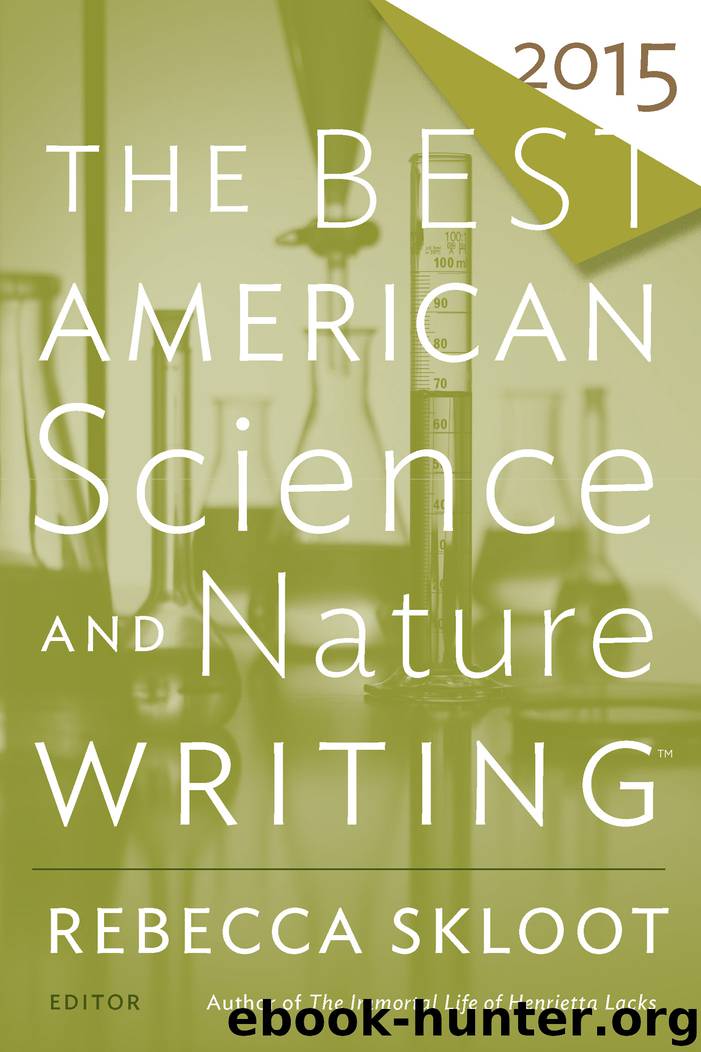The Best American Science and Nature Writing 2015 by Rebecca Skloot

Author:Rebecca Skloot
Language: eng
Format: epub
Publisher: Houghton Mifflin Harcourt
JOURDAN IMANI KEITH
At Risk
FROM Orion
THE TORRENTIAL RAIN in the first week of September pummels the youth crew’s tents at night, depositing mud and sediment in the creek where they pump water for drinking. For 17 days the teenagers I recruited to build trails for the North Cascades National Park are camping during one of the heaviest storms in 100 years. The river coughs thick brown mudslides onto State Route 20, blocking road access from the west. Instead of a three-and-a-half-hour drive to pick them up, I begin a seven-hour journey eastward from Seattle through rock formations that dart out like deer from the light-green sagebrush.
Arriving in the dark, I find the Pearrygin Lake campground outside of the Old West town of Winthrop barely occupied. The warm air is without insects, so I tuck myself in on the grass behind the white 12-passenger van I have rented to pick up the crew. Lying out under the stars without the nylon canopy of my tent, I nestle into the reflection of the half-moon and backlit mountains in the lake.
Despite my comfort, I am acutely aware that I am at risk: Black. Woman. Alone. Camping. Even in the disguising cloak of moonlight shadows, I need protection. I sleep with the van keys in my pocket and practice grabbing them to push the panic button in case of danger.
The spring chinook populations in the watersheds around Route 20 are labeled “at-risk populations” when the Forest Service discusses road analysis in the Methow River subbasin and its watersheds. They are protected under the Endangered Species Act. Protecting an endangered species means changing the practices in an entire ecosystem to safeguard their survival. It means managing the loss of their habitat, the turbidity of their waters, the surface water runoff from the streets that threatens them, and the effluents from the wastewater that disrupt their endocrine systems and, if unchecked, will cause their extinction.
Every year salmon return to the rivers where they were born. And every year I return to the birthplace of the wilderness program I developed to nurture the next generation of outdoor leaders in the cathedral peaks and azure lakes of the North Cascades. This year the wettest August followed by the heavy rains of September threatened both my crew of nascent campers and the eggs of the spawning salmon.
My youth crews are Black. Latino. Urban. This is what the woman at a party hears when I describe them. “Oh, you work with at-risk youth,” she says. She doesn’t hear Volunteer. College Student. Intern. Outdoor Leader. The “at-risk” label is different for youth than it is for salmon. “At-risk” isn’t a protection but a limitation, a judgment, an assumption. Even when the threats to their survival are the same as to an endangered species—an unstable habitat, lack of nutrition, and a damaged social and natural ecosystem—the label leaves them at a deficit, offers no promise for protection.
In the case of the salmon, being protected as an endangered species alerts us to the fullness of their connection to a magnificent web.
Download
This site does not store any files on its server. We only index and link to content provided by other sites. Please contact the content providers to delete copyright contents if any and email us, we'll remove relevant links or contents immediately.
| African American | Asian American |
| Classics | Anthologies |
| Drama | Hispanic |
| Humor | Native American |
| Poetry | Southern |
Crazy Rich Asians by Kevin Kwan(8883)
How to Bang a Billionaire by Alexis Hall(7930)
Little Fires Everywhere by Celeste Ng(6851)
Win Bigly by Scott Adams(6823)
Giovanni's Room by James Baldwin(6803)
Pachinko by Min Jin Lee(5427)
Tease (Temptation Series Book 4) by Ella Frank(5401)
The Fire Next Time by James Baldwin(5015)
The Perks of Being a Wallflower by Stephen Chbosky(4404)
China Rich Girlfriend by Kwan Kevin(4283)
First Position by Melissa Brayden(4271)
Bluets by Maggie Nelson(4258)
Rich People Problems by Kevin Kwan(4121)
The Sympathizer by Viet Thanh Nguyen(4091)
A Little Life (2015) by Hanya Yanagihara(4038)
Right Here, Right Now by Georgia Beers(3911)
Walking by Henry David Thoreau(3681)
Catherine Anderson - Comanche 03 by Indigo Blue(3467)
I'll Catch You by Farrah Rochon(3420)
